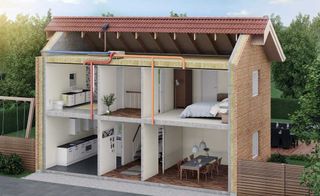Do MVHR and underfloor heating make a home more efficient? Our expert explains
Discover how the combination of MVHR and underfloor heating creates a comfortable living environment — and whether it'll ultimately be more energy efficient

MVHR and underfloor heating can work hand in hand to provide you with a living environment that's both cosy and cost-effective.
Though sometimes costly, this combination of cutting-edge technologies can offer a great return on investment — something highly-desirable for most homeowners. But you may be wondering if this dynamic duo is right for you.
In this article, energy expert David Hilton explains why installing both Mechanical Ventilation with Heat Recovery (MVHR) andunderfloor heating可能是一个精明的自助建站项目。
Why is MVHR and underfloor heating a good mix?
MVHRis designed to extract humid and stale air from wet rooms, such as bathrooms and kitchens, while simultaneously bringing in fresh air from outside. This air exchange occurs through a heat exchanger, preheating the fresh air before it enters habitable rooms.
Though MVHR and underfloor heating are not physically interconnected, they are frequently combined during the design and construction phase thanks to their synergistic qualities. The steady heat output of underfloor heating aligns well with the consistent ventilation provided by MVHR, ensuring a comfortable indoor environment.
What are the benefits of MVHR and UFH?
Opting for MVHR in conjunction with underfloor heating offers several advantages over traditional heating systems, such as radiators. Unlike radiators, underfloor heating distributes warmth evenly across the floor, eliminating the need for bulky radiators that can occupy valuable wall space.
The MVHR system's consistent ventilation lowers peak heat loads, reducing energy consumption and providing optimal comfort. This combination is particularly effective in well-insulated, energy-efficient homes.
How to install MVHR with underfloor heating?
Underfloor heating together with the ducting for a MVHR system can impact floor build up, especially in multi-story homes. So proper planning is necessary to accommodate the ductwork and pipework, ensuring they fit without compromising other design elements.
Sometimes the MVHR ductwork and underfloor pipework will need to be in the same place, especially in intermediate floor spaces such as between the ground and first floor. This can be a design challenge as well as an installation challenge. Whichever system gets installed first, the other one may need to be threaded through it without causing any damage. Any service risers will also need to be sized correctly to ensure that all the ductwork and pipework will not only physically fit but that it can also be practically installed. It is very important that if the two services are both in the same space that the installers are aware that the other will also need space so that everything fits.
There is no hard and fast rule as to who should go first but usually I would say the bigger items (except for some drains) should really go in first. That said, if the underfloor heating is to be installed on the underside of the first floor floorboards then in that case underfloor heating is the natural priority.
In my experience the easiest solution where projects have MVHR and underfloor heating in the same floorspace is to allow the ducts of the MVHR to run between the joists and then the UFH is fitted in overlay boards that are placed above the deck board. There will be more buildup on the floor level but if this is designed and specified early then the stairs and door frames can also be designed accordingly.

Can MVHR and UFH be installed on a DIY basis?
For the avid (and competent) DIY enthusiast both MVHR and underfloor heating represent the opportunity to potentially fit the ductwork and pipework yourself.
With good design and decent support the process of installing the ducts and pipework is not actually that difficult but can take time. You also have the opportunity to fit things at exactly the right time and not wait for the installation trades to be available. Do however make sure that you know what you are taking on, have the right tools and materials, and also allow enough time as these things do tend to take a bit longer than you may anticipate.
If you would like to read more about MVHR system costs and installation, you can read about my own experience in my article:I installed MVHR and it has completely stopped condensation in my home.
Get the Homebuilding & Renovating Newsletter
Bring your dream home to life with expert advice, how-to guides and design inspiration, direct to your inbox.
大卫是一个可再生能源和通风安装程序,with over 35 years experience, and is a long-standing contributor to Homebuilding and Renovating magazine. He is a member of the Gas Safe Register, has a Masters degree in Sustainable Architecture, and is an authority in sustainable building and energy efficiency, with extensive knowledge in building fabrics, heat recovery ventilation, renewables, and also conventional heating systems. He is also a speaker at the Homebuilding & Renovating Show.
Passionate about healthy, efficient homes, he is director of Heat and Energy Ltd. He works with architects, builders, self builders and renovators, and designs and project manages the installation of ventilation and heating systems to achieve the most energy efficient and cost effective outcome for every home.
- Gabriella DysonAssistant Editor
Most Popular
Bring your dream home to life with expert advice, how-to guides and design inspiration, direct to your inbox.
Thank you for signing up to Homebuilding. You will receive a verification email shortly.
There was a problem. Please refresh the page and try again.

